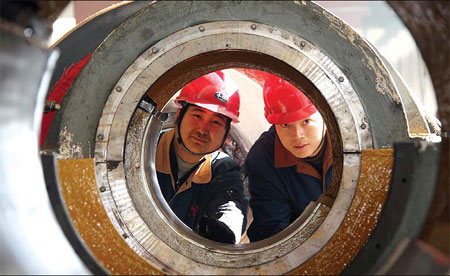Manufacturing output slows
Updated: 2011-12-31 09:02
By Chen Jia (China Daily)
|
|||||||||||
The December figure of 48.7 is below growth threshold of 50 for 2nd month
BEIJING - China's manufacturing output continued to fall in December, but the rate of decline has slowed, according to the latest HSBC Purchasing Managers' Index (PMI).
|
 |
|
A cement equipment manufacturing plant in Jiangsu province. Flagging manufacturing conditions signal that weakening external demand is staring to bite, says Qu Hongbin, chief China economist and co-head of Asian Economic Research at HSBC. [Photo/China Daily] |
According to HSBC Holdings PLC, December PMI - a main gauge of conditions in the manufacturing sector - rose to 48.7 from 47.7 in November and 51 in October, but was still below the growth threshold of 50. A reading below 50 means contraction, while one higher than that figure indicates expansion.
During the fourth quarter, the average PMI reading has dropped to the lowest point since the first three months of 2009, said HSBC.
The decline has sparked concerns about rising unemployment and a faster-than-expected cooling of economic expansion, which may prompt the government to ease its monetary policy sooner rather than later. The flagging manufacturing conditions signaled that weakening external demand is starting to bite, said Qu Hongbin, chief China economist and co-head of Asian Economic Research at HSBC. The ongoing slowdown in the property market is another factor for the cooling economy. "More aggressive action on both the fiscal and monetary fronts is needed to stabilize growth and jobs," Qu said.
A sub-index that shows new export orders fell for the first time in three months. It was approximately 15 percent lower than in November, indicating weaker external demand.
Meanwhile, the number of jobs in the manufacturing sector declined slightly in December - the first decrease since September - reflecting the fact that businesses have started "downsizing", according to the HSBC report.
Peng Wensheng, chief economist with China International Capital Corp, said that the central government may come under more pressure to control the unemployment rate if job losses continue in the coming months.
Industrial output for December also is expected to register a further slowdown to 12.1 percent year-on-year, compared with 12.4 percent in November, according to Peng. The data will be released in January.
The People's Bank of China (PBOC), the central bank, may cut the reserve-requirement ratio (RRR) for lenders - the amount of money that commercial banks must set aside as reserves - at the beginning of January by 50 basic points, to prevent an economic hard landing, he said.
"New-yuan lending is increasing and it is expected to reach 560 billion yuan ($88 billion) this month," Peng said. "The broad money supply (know as M2) may also grow faster in the first month next year."
"A hard-landing should be avoided as long as the easing measures filter through in the coming months," Qu said.
The PBOC cut the RRR ratio for lenders earlier this month in response to the deterioration of manufacturing activity and to help small and medium-sized businesses raise capital.
In addition to a loosening of monetary policy, it will also be necessary to cut company taxes to increase profits and create more jobs, analysts said.
Related Stories
Indexes indicate slowing growth 2011-09-05 07:51
PMI falls 2011-08-02 17:12
Chinese PMI rose in August 2011-09-02 14:25
China's manufacturing continues to contract in Sept 2011-09-22 15:55
- PBOC stresses prudent monetary policy for 2012
- Safety risks of Subaru vehicles warned
- Aflatoxin level in milk products normal: AQSIQ
- RQFII gets investment quota of 10.7b yuan
- Glitches Hamper Web sales of tickets
- Manufacturing output slows in Dec
- CSRC tightens disclosure rules
- School buses to meet national conditions









